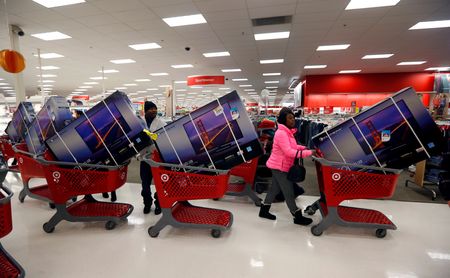By Lucia Mutikani
WASHINGTON (Reuters) – U.S. retail sales increased by the most in nearly two years in January after two straight monthly declines as Americans boosted purchases of motor vehicles and other goods, pointing to the economy’s continued resilience despite higher borrowing costs.
Coming on the heels of news on Tuesday that monthly inflation picked up last month, signs of strength in consumer spending could fuel financial market speculation that the Federal Reserve could continue raising interest rates through summer to cool domestic demand.
Robust retail sales gains, together with other data on Wednesday showing production at factories improving last month, led economists to raise their economic growth forecasts for the first quarter and declare that there was no imminent recession.
But fears that the U.S. central bank could lift borrowing costs higher than currently thought are keeping expectations of a downturn in the second half on the table.
“Every day the economy does not lose steam, the risks go up astronomically that the Fed will lose patience and make those recession forecasts a reality by jacking up rates too high,” said Christopher Rupkey, chief economist at FWDBONDS in New York. “There’s no roadmap for the central bank seeing data like this.”
The Commerce Department said that retail sales surged 3.0% last month, the largest increase since March 2021, after declining by an unrevised 1.1% in December.
Economists polled by Reuters had forecast sales would increase 1.8%, with estimates ranging from 0.5% to 3.0%. Retail sales vaulted 6.4% year-on-year in January. Retail sales are mostly goods and are not adjusted for inflation.
The drop in sales in the prior two months was blamed on the front-loading of holiday shopping, which economists said had not been fully adjusted for by the model that the government uses to strip out seasonal fluctuations from the data.
The so-called seasonal adjustment factors likely flattered retail sales in January and some economists expected a reversal in retail sales in February. The blowout job growth in January was partially attributed to seasonal adjustment factors.
“The bottom line is that the underlying trend in consumption is not as weak as the December numbers indicated, but is also not as strong as the January numbers might suggest,” said Lou Crandall, chief economist at Wrightson ICAP.
But even accounting for the technical distortions, Americans are still spending.
The Bank of America Institute last week reported a surge in spending in January based on an analysis of Bank of America credit and debit card data. It said this suggested “that while lower-income consumers are pressured, they still have solid cash buffers and borrowing capacity,” noting “even for the lowest- income cohorts this should provide support for some time yet.”
Citi card data also showed gains in services spending.
Last month’s broad increase in retail sales was led by motor vehicle purchases, with receipts at auto dealers accelerating 5.9%. Sales at service stations were unchanged, despite rising gasoline prices. Online retail sales rebounded 1.3%.
Furniture stores sales jumped 4.4%. Receipts at food services and drinking places, the only services category in the retail sales report, soared 7.2%. Electronics and appliance store sales shot up 3.5%.
There were also hefty increases in clothing stores sales as well as receipts at general merchandise and health and personal care stores. Sporting goods, hobby and musical instrument stores eked out a 0.2% gain, while building material and garden equipment supplier receipts climbed 0.3%.
Stocks on Wall Street was trading lower. The dollar rose against a basket of currencies. U.S. Treasury prices fell.
GRAPHIC: Retail sales (https://www.reuters.com/graphics/USA-STOCKS/akpeqmkadpr/rs.png)
BROAD SALES GAINS
In addition to credit card debt, retail sales were also likely supported by the biggest cost of living adjustment since 1981 for more than 65 million Social Security beneficiaries, which came into effect in January. Several states also raised their minimum wage.
The tight labor market, marked by the lowest unemployment rate in more than 53 years, continues to generate strong wage growth, though the pace has slowed. The Fed has raised its policy rate by 450 basis points since last March from near zero to a 4.50%-4.75% range, with the bulk of the increases between May and December. Two additional rate hikes of 25 basis points are expected in March and May.
Financial markets are betting on another increase in June.
The government reported on Tuesday that consumer prices accelerated in January and the pace of disinflation in the year-on-year rate slowed.
“The resiliency of the consumer will likely add to the Fed’s desire to keep rates higher for longer to help rebalance demand and supply in the economy,” said Conrad DeQuadros, senior economic advisor at Brean Capital in New York.
Excluding automobiles, gasoline, building materials and food services, retail sales increased 1.7% last month. That was the largest gain in the so-called core retail sales in a year and followed an unrevised 0.7% decline in December.
Core retail sales correspond most closely with the consumer spending component of gross domestic product. JPMorgan raised its first-quarter GDP growth forecast to a 2.0% annualized rate from a 1.0% pace. Goldman Sachs boosted its tracking estimate by 0.6 percentage point to a 1.4% rate. The economy grew at 2.9% rate in the fourth quarter.
While manufacturing production has weakened, it appears a recession in the sector would be mild. A separate report from the Fed on Wednesday showed production at factories rebounded 1.0% in January.
A third report showed business conditions in New York state improving in February and companies growing more upbeat about prospects over the next six months. But a rebound in manufacturing could be limited by businesses carefully managing inventory.
GRAPHIC: Business inventories (https://www.reuters.com/graphics/USA-STOCKS/zdpxdnzrwpx/businv.png)
“Activity still looks set to face challenges this year,” said Tim Quinlan, a senior economist at Wells Fargo in Charlotte, North Carolina.
(Reporting by Lucia Mutikani; Editing by Paul Simao and Andrea Ricci)

